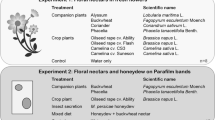Abstract
Females ofEphedrus cerasicola Starý were released into small glasshouses (13.6 m3) or cages (0.125 m3) which contained paprika plants in 2 of the following categories: fresh plants (without honeydew and aphids), honeydew-contaminated plants (aphids removed) and aphid-infested plants (with honeydew). Two hundred females were released into each glasshouse with 20 plants, 10 of each category, while 10 females were released into the cages with 2 plants, one of each category. Control experiments with only fresh plants were conducted in both the glasshouses and the cages. The female parasitoids on each plant were counted at regular intervals for 24 or 48 h in the glasshouse and for 4 h in the cage experiments; this number was used as an indicator of plant preferences. The following preferences were established (preferred plant > less preferred plant): honeydew-plant > fresh plant, aphid-plant > fresh plant, aphid-plant > honeydew-plant. The number of females on the aphid-plants increased throughout the experimental period, whereas the number on the honeydew-plants tended to be more stable.
Résumé
Des femelles d'Ephedrus cerasicola Starý ont été lâchées dans des petites serres (13,6 m3) ou des cages (0,125 m3) qui contenaient des plants de paprika de 2 types: plants frais (sans miellat, ni pucerons), plants recouverts de miellat sans pucerons et plants infestés par les pucerons (avec miellat). Deux cent femelles ont été lâchées dans chaque serre avec 20 plants, dix de chaque type, tandis que 10 femelles étaient lâchées dans les cages avec 2 plants, un de chaque type. Les expériences de contrôle étaient menées avec uniquement des plants frais à la fois dans les serres et en cages. Les femelles de parasitoïde étaient dénombrées sur chaque plant à intervalle régulier de 24 heures ou 48 heures en serre et toutes les 4 heures dans les cages expérimentales; leur nombre était utilisé en tant qu'indicateur de choix. Les choix suivants ont été établis (plante préférée > plante moins visitée) miellat-plante > plante fraîche, puceron-plante > plante fraîche, pucerons-plante > miellat-plante. Le nombre de femelles sur les plants infestés de pucerons augmentait au cours de l'expérimentation, tandis que leur nombre sur les plants couverts de miellat tendait à demeurer plus stable.
Similar content being viewed by others
References
Akinlosotu, T. A. — 1978. Some aspects of the host finding behaviour of the femaleDiaeretiella rapae McIntosh [Hymenoptera: Aphidiidae] —Nigerian J. Entomol., 1, 11–18.
Ayal, Y. — 1987. The foraging strategy ofDiaeretiella rapae. I. The concept of the elementary unit of foraging. —J. Anim. Ecol., 56, 1057–1068.
Bouchard, Y. &Cloutier, C. — 1984. Honeydew as a source of host-searching kairomones for the aphid parasitoidAphidius nigripes [Hymenoptera: Aphidiidae]. —Can. J. Zool., 62, 1513–1520.
Bouchard, Y. &Cloutier, C. — 1985. Role of olfaction in host finding by aphid parasitoidAphidius nigripes [Hymenoptera: Aphidiidae]. —J. Chem. Ecol., 11, 801–808.
Gärdenfors, U. — 1986 Taxonomic and biological revision of PalearcticEphedrus Haliday [Hymenoptera: Braconidae, Aphidiinae]. —Entomol. scand. Suppl., 27, 1–95.
Gardner, S. &Dixon, A. F. G. — 1985. Plant structure and the foraging success ofAphidius rhopalosiphi [Hymenoptera: Aphidiidae]. —Ecol. Entomol., 10, 171–179.
Hill, D. S. — 1987. Agricultural insect pests of temperate regions and their control. —Cambridge University Press, Cambridge, 659 pp.
Hågvar, E. B. &Hofsvang, T. — 1987. Foraging by the aphid parasitoidEphedrus cerasicola for patchily distributed hosts. —Entomol. Exp. Appl., 44, 81–88.
Mackauer, M. &Starý, P; — 1967. Hym. Ichneumonoidea, World Aphidiidae. In: Index of entomophagous insects (V. Delucchi &G. Remaudière, eds.). —Le François, Paris, 1–195.
Powell, W. &Zhang Zhi-Li. — 1983. The reactions of two cereal aphid parasitoids,Aphidius uzbekistanicus andA. ervi to host aphids and their food-plants. —Physiol. Entomol., 8, 439–443.
Read, D. P., Feeny, P. P. &Root, R. B. — 1970. Habitat selection by the aphid parasiteDiaeretiella rapae [Hymenoptera: Braconidae] and hyperparasiteCharips brassicae [Hymenoptera: Cynipidae]. —Can. Entomol., 102, 1567–1578.
Schuster, D. J. &Starks, K. J. — 1974. Response ofLysiphlebus testaceipes in an olfactometer to a host and a non-host insect and to plants. —Environ. Entomol., 3, 1034–1035.
Starý, P; — 1976. Aphid parasites [Hymenoptera, Aphidiidae] of the Mediterranean area. —Dr. W. Junk B. V., The Hague.
Welch, B. L. — 1947. The generalization of “Student” problem when several different population variances are involved. —Biometrika, 34, 28–35.
Author information
Authors and Affiliations
Rights and permissions
About this article
Cite this article
Hågvar, E.B., Hofsvang, T. Effect of honeydew and hosts on plant colonization by the aphid parasitoidEphedrus cerasicola . Entomophaga 34, 495–501 (1989). https://doi.org/10.1007/BF02374387
Received:
Accepted:
Issue Date:
DOI: https://doi.org/10.1007/BF02374387




